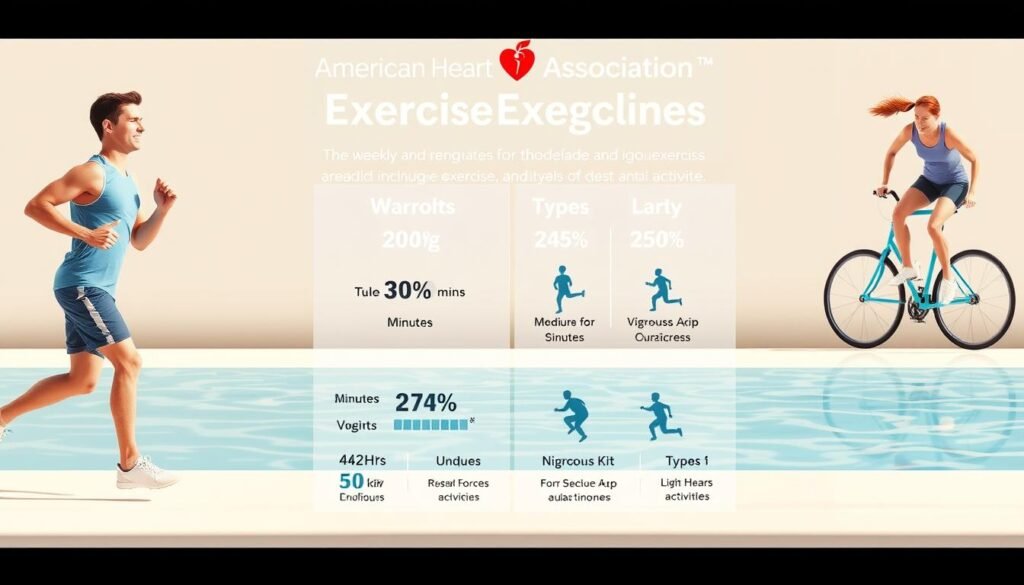Did you know that heart disease remains the leading cause of death in the U.S., yet simple lifestyle changes can drastically reduce risks? A strong heart is the cornerstone of overall wellness, yet modern habits—like prolonged sitting and poor nutrition—threaten its function. The good news? Moving more is one of the most effective ways to protect it.
The CDC reports that nearly 655,000 Americans die from heart-related conditions annually. However, the World Health Organization highlights that just 150 minutes of moderate activity per week can make a difference. This article breaks down how staying active strengthens your heart, improves circulation, and supports long-term vitality.
Key Takeaways
- Heart disease is the top cause of death in the U.S., but prevention is possible.
- Sedentary lifestyles increase risks, while movement counters them.
- Just 150 minutes of weekly activity can boost heart function.
- Exercise enhances blood flow and lowers stress on the heart.
- Consistency matters—small, regular efforts yield lasting results.
Introduction: Why Heart Health Starts with Movement
The human heart thrives on movement—a fact our ancestors understood but modern life often ignores. Our cardiovascular system evolved to pump blood efficiently through physical activity, not prolonged sitting. When we move, arteries expand and contract like elastic tubes, maintaining their youthful flexibility.
Sedentary habits allow plaque to accumulate silently. The American Heart Association warns that inactivity contributes to 250,000 U.S. deaths annually from heart disease. Like stagnant water breeds mosquitoes, still blood promotes fatty deposits that narrow arteries over time.
A 2023 JAMA study revealed something startling: walking 30 minutes daily works as well as medications for reducing early death risk in some patients. Movement triggers biochemical signals that repair blood vessels and regulate metabolism simultaneously.
Physical activity immediately improves endothelial function—the inner lining of blood vessels. The shear stress from movement stimulates nitric oxide production, which lowers blood pressure within hours. These effects compound over time like interest in a health savings account.
The obesity epidemic magnifies these challenges. Excess weight strains the heart while promoting diabetes and chronic inflammation. Yet research confirms that movement regulates blood sugar and reduces arterial swelling better than any single pill.
This article bridges laboratory findings with practical steps. From understanding how your heart adapts to activity, to choosing workouts that deliver maximum protection—we’ll explore science-backed strategies for lifelong cardiovascular resilience.
Key Cardiovascular Benefits of Regular Exercise
Science confirms that staying active directly strengthens your circulatory system. Physical activity triggers biological changes that protect against hypertension, poor cholesterol, and chronic inflammation—three major contributors to heart disease.
Lower Blood Pressure and Reduced Hypertension Risk
Movement naturally lowers blood pressure by stimulating nitric oxide production. This compound relaxes arteries, improving blood flow. Johns Hopkins research shows aerobic activity reduces systolic pressure by 4–9 mmHg.
The American Heart Association notes 150 weekly minutes of exercise slashes hypertension risk by 34%. Even small drops matter—every 2mmHg decrease cuts stroke mortality by 10%.

Improved Cholesterol Levels
Aerobic workouts like cycling elevate HDL (good cholesterol) levels by 3–6%. They also reduce triglycerides, fatty particles that clog arteries. Studies suggest consistent training rivals statins for lipid management.
A 6-month cycling program reversed metabolic syndrome in 60% of participants. For real-time tracking, wrist monitors help visualize progress.
Decreased Inflammation Throughout the Body
Exercise reduces inflammation markers like C-reactive protein (CRP) by 30%. Chronic swelling damages blood vessels, but movement releases myokines—proteins that combat systemic inflammation.
The EPIC-Norfolk study found active adults halved their coronary artery disease risk. Start gradually if you have hypertension, and consult a doctor for tailored plans.
How Exercise Combats Heart Disease Risk Factors
Diabetes and obesity amplify heart risks, but structured activity can reverse their impact. The NIH confirms that losing just 7% body weight paired with 150 minutes of weekly movement slashes diabetes risk by 58%. This isn’t just about burning calories—it’s about resetting your body’s metabolic wiring.
Modifying Diabetes and Obesity-Related Risks
Physical activity supercharges your muscle cells’ ability to absorb sugar. During movement, muscles activate GLUT4 transporters—proteins that pull glucose from the bloodstream like magnets. A Duke University trial found HIIT workouts improved insulin sensitivity by 28% in prediabetic adults.
Obesity strains the heart by forcing it to pump blood through miles of extra capillaries. But visceral fat isn’t permanent—a 12-month Johns Hopkins study saw participants reverse metabolic syndrome through cycling and strength training. Continuous glucose monitors now let users track real-time improvements, turning data into motivation.
Strengthening the Heart Muscle Efficiency
Your heart adapts to activity like any other muscle. Athletes develop thicker left ventricles, allowing stronger pumps with fewer beats. Even beginners see gains: a resting heart rate drop of 5–10 BPM signals improved vagal tone from just 8 weeks of brisk walking.
ECG-monitored studies reveal aerobic and resistance training yield different benefits. While running enhances oxygen use, weightlifting increases stroke volume—the blood pumped per beat. The American College of Cardiology recommends blending both for optimal heart resilience.
The Science Behind Exercise and Heart Health
Cutting-edge research reveals how physical activity rewires your heart at a cellular level. Every workout triggers biological upgrades that enhance oxygen delivery and combat disease. These adaptations explain why active individuals often show younger cardiovascular systems than their sedentary peers.
Myocardial Adaptations: Oxygen Utilization and Blood Flow
Your heart muscle becomes more efficient through exercise-induced changes. Aerobic activity stimulates PGC-1α proteins in cardiac cells, boosting mitochondria that convert oxygen into energy. This process improves blood flow by up to 20% in coronary arteries.

VEGF proteins grow new blood vessels during workouts, creating alternative routes around potential blockages. Studies show athletes develop 15% denser capillary networks. For beginners, even brisk walking enhances oxygen extraction within weeks.
Role of Myokines in Reducing Systemic Inflammation
Moving your muscle tissue releases irisin, a hormone that drops inflammation markers by 40%. Nature journal studies confirm this myokine blocks TNF-α, a compound linked to arterial damage. Regular aerobic exercise keeps these protective signals flowing.
AMPK enzymes activated during workouts help burn fatty acids instead of storing them. Cardiac MRIs reveal better perfusion in active adults, with VO2 max scores predicting longevity. Always consult a doctor if experiencing chest pain during activity, as some heart changes need evaluation.
Ideal Exercises for Cardiovascular Fitness
Not all workouts are created equal when it comes to strengthening your cardiovascular system. The American Heart Association emphasizes a dual approach: 30 minutes of daily aerobic movement paired with twice-weekly resistance sessions. This combination optimizes blood flow while enhancing muscular support for your heart.
Aerobic Activities: Walking, Swimming, and Cycling
Low-impact options like brisk walking improve circulation without joint strain. A MET-based analysis shows swimming burns 400+ calories hourly while engaging the upper muscle groups. Cycling outdoors or on platforms like Zwift offers adjustable intensity, with studies favoring Assault bikes for calorie burn.
For beginners, the 6-minute walk test tracks progress. Outdoor workouts add environmental benefits—sunlight exposure boosts vitamin D, linked to lower hypertension rates. Chair-based adaptations ensure accessibility for all fitness levels.
Resistance Training: Weightlifting for Heart Resilience
Lifting weights strengthens the heart by improving stroke volume—the blood pumped per beat. Focus on compound movements with neutral spine alignment, progressing intensity by 5% weekly. Hybrid programs like CrossFit blend aerobic and strength elements for metabolic conditioning.
The RPE (Rate of Perceived Exertion) scale helps beginners gauge effort safely. Research confirms that combining dumbbell routines with cycling reduces arterial stiffness 23% more than cardio alone. Always prioritize form over weight to prevent injury.
Exercise Recommendations from the American Heart Association
The American Heart Association‘s updated guidelines offer precise roadmaps for heart-healthy movement. Their 2023 standards emphasize flexibility, allowing adults to choose between vigorous or moderate physical activity based on preference and capability.
Minimum Weekly Targets for Adults
For optimal results, aim for 150–300 minutes of moderate activity or 75–150 minutes of vigorous movement per week. This aligns with lactate threshold research, where intensity is measured via breath analysis during exertion.

Seniors over 65 should modify durations but maintain frequency. The “talk test” helps gauge effort—able to speak but not sing during moderate activity, while vigorous effort allows only brief phrases.
Balancing Intensity: Moderate vs. Vigorous Activity
Brisk walking (3–4 mph) typifies moderate aerobic exercise, while running doubles calorie burn. Tools like WHOOP’s strain coach quantify effort, and MET-hour tracking simplifies progress monitoring.
For diabetics, the ADA recommends post-meal walks to stabilize blood sugar. Cultural practices like Zumba or treadmill desk conversions also count, proving heart health adapts to lifestyles.
The CDC’s Active People Initiative underscores how small changes—like three 10-minute walks daily—compound into measurable public health gains.
Exercise for Specific Populations
Heart health isn’t one-size-fits-all—special populations require adapted approaches. The American College of Sports Medicine emphasizes customized plans for pregnant women and heart disease patients. These guidelines balance safety with physiological benefits, from trimester-specific modifications to post-surgical protocols.
Safe Routines for Pregnant Women
Obstetricians recommend capping target heart rates at 140 bpm during the first trimester. As pregnancy progresses, water aerobics and prenatal yoga reduce joint stress while maintaining circulation. The Borg Scale helps monitor exertion—able to converse comfortably indicates safe intensity.
Postpartum recovery requires diastasis recti precautions. Pelvic tilts and heel slides rebuild core strength without straining abdominal separation. Johns Hopkins research shows structured physical activity reduces postpartum depression risks by 40%.
Guidelines for Heart Disease Patients
Cardiac rehab progresses through four phases: inpatient, supervised outpatient, monitored home programs, and lifelong maintenance. For ICD patients, electromagnetic precautions include maintaining 12-inch clearance from gym equipment. Beta-blocker users should track perceived exertion rather than heart rate due to medication effects.
The MyCardiacCoach app helps track progress with medication reminders and symptom logs. Cultural adaptations matter—faith-based walking groups improve adherence in minority communities. Emerging research explores congenital heart disease patients’ unique needs through pediatric exercise studies.
Measuring Progress: Heart Rate, Endurance, and Body Composition
Tracking your heart’s response to movement reveals how fitness transforms your health. Data-driven insights help optimize workouts and celebrate milestones. Whether you’re a beginner or athlete, understanding key metrics ensures smarter effort.
Target Heart Rate Zones Explained
The Karvonen formula personalizes intensity: Target HR = [(220 – age) – resting HR] × intensity% + resting HR. For a 40-year-old with a resting HR of 60, moderate effort (60% intensity) lands at 132 BPM.
Wearables like Polar H10 chest straps outperform optical sensors (e.g., Apple Watch) during HIIT. Field tests like the Rockport Walk Test estimate VO2 max without lab equipment. Watch for overtraining markers—persistent elevated resting HR signals strain.
Tracking Fat Loss and Muscle Gain
DEXA scans reveal body composition shifts, separating lean mass from fat. Bioelectrical impedance scales (Withings Body+) track trends but vary with hydration. Remember: scale weight may plateau while muscle gain reshapes your physique.
Progress photos beat scales for visual proof of fat loss. Lactate threshold curves measure endurance gains—elite runners sustain 85% max HR for hours. Pair metrics with how you feel; energy levels often reflect internal upgrades first.
Recognizing Overtraining and Staying Safe
Your heart rate holds clues about whether you’re training smart or straining too much. The American College of Sports Medicine notes that a resting pulse spike above 10 BPM signals excessive stress on your system. Staying safe means balancing effort with recovery.
Warning Signs of Excessive Strain
RED-S syndrome markers include irregular periods in women and plummeting testosterone in men. Biochemical tests reveal cortisol/DHEA imbalances—a key indicator of systemic overload.
Heart rate variability (HRV) apps like Elite HRV help track recovery needs. Persistent muscle soreness, insomnia, or irritability signal it’s time to deload. Heat illness prevention requires hydration checks and cooling vests in summer.
When to Consult a Doctor
Chest tightness or nausea during activity warrants immediate medical review. Sports cardiologists use ECGs to detect arrhythmias linked to overtraining. AEDs should be accessible in all gyms—ask staff about emergency protocols.
NSAIDs like ibuprofen can mask pain but delay healing. For those with existing conditions, pre-participation screening forms identify hidden risk factors. Remember: long-term health beats short-term gains.
Combining Exercise with Diet for Optimal Results
Fueling your body properly amplifies the heart-protective effects of movement. A landmark NEJM study found pairing Mediterranean diet principles with physical activity reduces cardiovascular events by 35%—more than either approach alone.

Synergistic Effects of Nutrition and Physical Activity
Timing nutrients around workouts enhances their impact. Consuming lean protein within 45 minutes post-exercise helps rebuild muscle fibers stressed during activity. Anti-inflammatory foods like fatty fish complement exercise’s natural inflammation reduction.
The DASH and MIND diets show particular promise. Both emphasize whole foods that support circulation while controlling weight. Adding prebiotic fibers from oats or bananas feeds gut microbes linked to better nutrient absorption.
Short-Term vs. Long-Term Weight Management
Crash diets often backfire by slowing metabolism. Sustainable approaches combine portion control with consistent movement. Waist-to-height ratio proves more revealing than scale numbers alone for tracking progress.
Programs like Noom use behavioral psychology to create lasting habits. Their success stems from addressing why we eat, not just what we eat. Small changes—like swapping soda for sparkling water—compound over time.
Electrolyte balance matters too. Proper hydration with potassium-rich foods helps maintain steady heart rhythms during activity. This creates a foundation for lifelong health.
Motivation Strategies for Lifelong Fitness
What separates temporary gym members from lifelong exercisers? Sustainable motivation systems. Lasting fitness isn’t about short-term willpower—it’s built through psychological triggers and environmental design. Research shows that people who embed activity into their routine are 300% more likely to maintain it long-term.
Social Support and Accountability
The Journal of Behavioral Medicine found that accountability partners increase workout adherence by 65%. Digital tools amplify this effect—Strava clubs create friendly competition, while Fitbit challenges turn steps into team achievements.
Behavioral contracts through platforms like StickK.com use financial stakes to reinforce commitment. Cultural preferences matter too: collective societies thrive with group classes, while individualists may prefer solo tracking apps.
Setting Realistic Goals and Celebrating Milestones
SMART goals (Specific, Measurable, Achievable, Relevant, Time-bound) prevent burnout. Instead of “get fit,” aim for “walk 30 minutes daily before work.” Non-food rewards like massage guns reinforce positive habits.
Corporate wellness programs show the power of environment—employees given standing desks move 50% more. Analog methods work too: wall calendars with gold stars satisfy our brain’s love for visual progress tracking. The key? Make movement part of your life, not just your schedule.
Debunking Myths About Exercise and Heart Health
Many fitness myths persist despite scientific evidence proving otherwise. From outdated “no pain, no gain” mantras to age-related misconceptions, these false beliefs often prevent people from starting or maintaining exercise routines.
“No Pain, No Gain” Misconceptions
The idea that workouts must hurt to be effective is dangerously misleading. While muscle fatigue is normal, sharp pain increases risk of injury. A 2022 Sports Medicine study found moderate-intensity training delivers 89% of health gains without extreme discomfort.
Spot reduction claims are equally flawed. You can’t target belly fat through crunches alone—the body burns fat systemically. EMS training devices show temporary muscle contraction but don’t replace active movement for heart health.
Age and Exercise: It’s Never Too Late
A Circulation journal study proved adults over 70 gain equal percentage improvements in VO2 max as younger individuals. Sarcopenia (muscle loss) can be reversed at any age through resistance training.
Centenarian marathoners like Fauja Singh demonstrate the lifelong benefits of movement. For those with existing heart disease, supervised programs show equal safety and effectiveness across age groups.
Remember: movement adapts to your capabilities. Chair yoga and water aerobics prove accessibility isn’t about intensity—it’s about consistency.
Conclusion: Your Heart’s Future Starts Today
Your heart’s strength isn’t fixed—it evolves with every step you take. Small changes like walking meetings or stair climbing compound into measurable health gains over time.
Track progress with the AHA’s Check.Change.Control tool and reliable heart rate monitors. These tools turn abstract heart health goals into visible achievements.
The benefits extend beyond medical metrics—active lifestyles enrich relationships and daily experiences. Local cardiac rehab programs provide built-in support systems.
Blend movement with your fitness preferences, whether dancing, gardening, or swimming. Policy changes like walkable neighborhoods make healthy choices easier for entire communities.
Your next heartbeat begins a better life chapter. Start today—your future self will thank you for each small, heart-smart decision.
FAQ
How does movement improve heart health?
Physical activity strengthens the heart muscle, lowers blood pressure, and enhances circulation. The American Heart Association recommends at least 150 minutes of moderate exercise weekly.
Can walking reduce hypertension risks?
Yes, brisk walking for 30 minutes daily helps manage blood pressure. Studies show it decreases stress on arteries and improves overall cardiovascular function.
What role does resistance training play in heart resilience?
Weightlifting and bodyweight exercises increase lean muscle mass, which improves metabolism and reduces obesity-related risks linked to heart disease.
Are there specific exercises for people with diabetes?
Aerobic activities like cycling paired with strength training help regulate blood sugar levels. Always consult a doctor before starting new routines.
How does exercise combat systemic inflammation?
Movement releases myokines, proteins that reduce inflammation throughout the body. This lowers risks for chronic conditions tied to heart disease.
What’s the safest way for pregnant women to stay active?
Low-impact exercises like swimming or prenatal yoga maintain fitness without strain. The American Heart Association suggests modified routines based on trimester.
Can you rebuild heart strength after a heart attack?
Cardiac rehabilitation programs use supervised aerobic exercise to restore function. Gradual progression under medical guidance is key.
How do I know if I’m overtraining?
Warning signs include persistent fatigue, irregular heart rate, and joint pain. Reduce intensity and seek medical advice if symptoms last over a week.
Does nutrition amplify exercise benefits for the heart?
A balanced diet rich in omega-3s, fiber, and antioxidants works synergistically with physical activity to improve cholesterol and blood pressure.
Is high-intensity interval training safe for beginners?
Start with shorter intervals and moderate effort. Build endurance over time to avoid excessive strain on the cardiovascular system.



